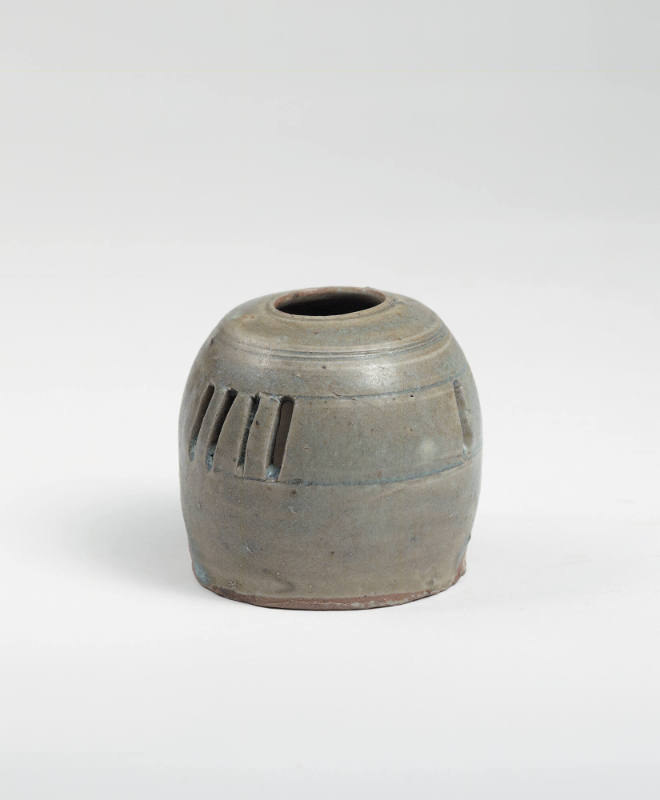


Object Details
Culture
Moche (Peru)
Date
AD 100-600
Medium
Earthenware
Dimensions
9 13/16 × 5 5/16 × 6 11/16 inches (25 × 13.5 × 17 cm)
Credit Line
Gift of Thomas Carroll, PhD 1951
Object
Number
2006.070.394
BRIEF DESCRIPTIONAn effigy vessel is a container that is made in the shape of a person or an animal.(…)
BRIEF DESCRIPTIONAn effigy vessel is a container that is made in the shape of a person or an animal. This Moche vessel is in the form of a shaman Owl Priest, with an owl-shaped face and fanged feline mouth. Birds and felines are among the most common shamanic helper spirits.WHERE WAS IT MADE?This vessel comes from the north coastal region of what is now Peru.HOW WAS IT MADE?The Moche made many of their ceramics using two-part press molds, a technique that enabled potters to make multiple pots of uniform design. First an original form was made from clay. After creating the mold (also ceramic) from this original, clay would be pressed into each half, and then later joined together. Sometimes hand modeling or coiling would also be utilized, and more than one technique could be used to produce a single pot.The clay used to make these vessels is known as terracotta, and the presence of iron in the clay gives it the reddish-brown hue. When the ceramics were fired in shallow earthen pits, the presence of heat and oxygen would oxidize the iron in the clay, enhancing the colors of brown, red and orange. The combination of red and tan designs is characteristic of Moche ceramics. White clay was used to produce a paint called slip (clay diluted with water), which could then be applied to create designs. Sometimes the white slip was used to create the ground, while red slip was used to add the designs. After the slip dried, but before the clay was fired, pieces were often burnished, as this one has been.HOW WAS IT USED?Bottles of this stirrup-spout type may have been used to carry and serve liquids, since the narrow-necked bottle shape would have reduced losses from accidental spills and evaporation. Although water is vital in desert environments such as those found in many parts of the Andes, recent analyses of residues from Peruvian bottles and jars suggest that most of them were used to serve corn (maize) beer or chicha. Chicha was both an everyday beverage, made in households for family consumption, and an essential element in ritual and social interactions.WHY DOES IT LOOK LIKE THIS?Notice how the figure is depicted wearing heavy long white clothing that prevents us from seeing the upper arms and crossed legs. This attire is characteristic of priests. Two solid red bands are painted around the shoulders, extending down the back, possibly representing a cloak or binding. Also notice the headdress decorated with a patterned geometric headband under a plain cover.Half-human, half-owl shamans (religious specialists) played an important role in Moche cosmology, being an integral part of the “presentation” or “warrior sacrifice” story that has been identified as the central theme depicted on Moche fineline ceramics. Birds are often symbolic of the spirit flight taken by a shaman or religious specialist during a vision quest, when the shaman is said to transform into a bird in order to transcend the material world and communicate with ancestor spirits. Often aided by hallucinogenic drugs, a shaman’s spirit would fly out from his body in search of knowledge and spiritual fulfillment. Elsewhere in the Americas, owls are often associated with death, perhaps because of their uncannily silent flying as they hunt in the darkness of night.ABOUT THE MOCHE CULTURE:Arguably one of the finest technological manifestations of the pre-Columbian potter’s art, Moche ceramics have charmed generations of archaeologists and collectors with their finely executed painting and exquisite sculptural forms. Moche (formerly known as Mochica) pottery is characterized by red painting executed on a white or cream-colored slip ground. Moche stirrup-spout bottles represent a wide variety of sculptural forms, including human portaits, animal effigies, domestic scenes, or graphic human sexuality. The core area of Moche cultural influence extended from Lambayeque in the north to Nepeña in the south, and likely reflects militaristic conquest and political control by a state-level polity centered in the Moche Valley. The Moche united many coastal groups, built and controlled extensive irrigation networks, and produced ceramic vessels using molds, a technological innovation which enabled the production of vast numbers of highly detailed ceramics, including portrait head vessels so finely detailed that individual faces can be recognized. Fineline paintings depict detailed, elaborate scenes now thought to be part of the “warrior sacrifice” or “presentation theme” story central to the Moche religion. Moche metalwork also achieved remarkable levels of sophistication, with precious stones inlaid in ornaments made of copper, silver, and gold alloys.












